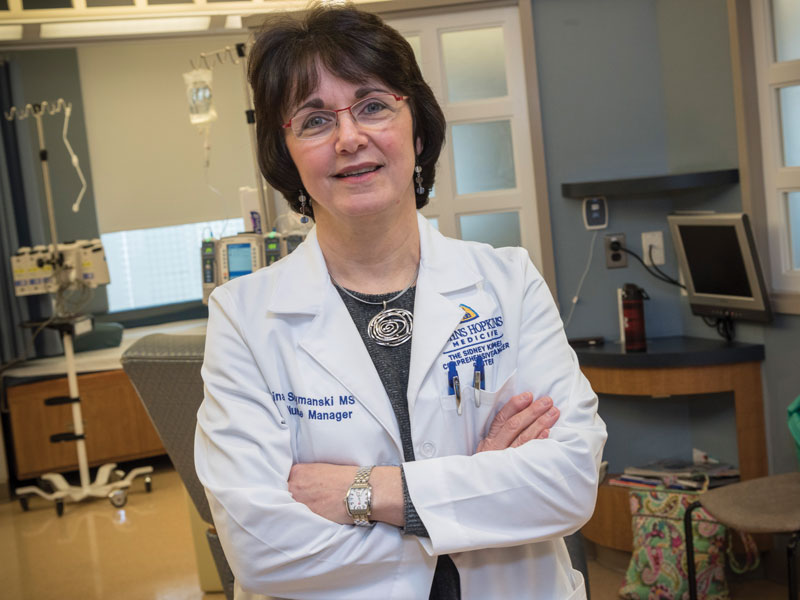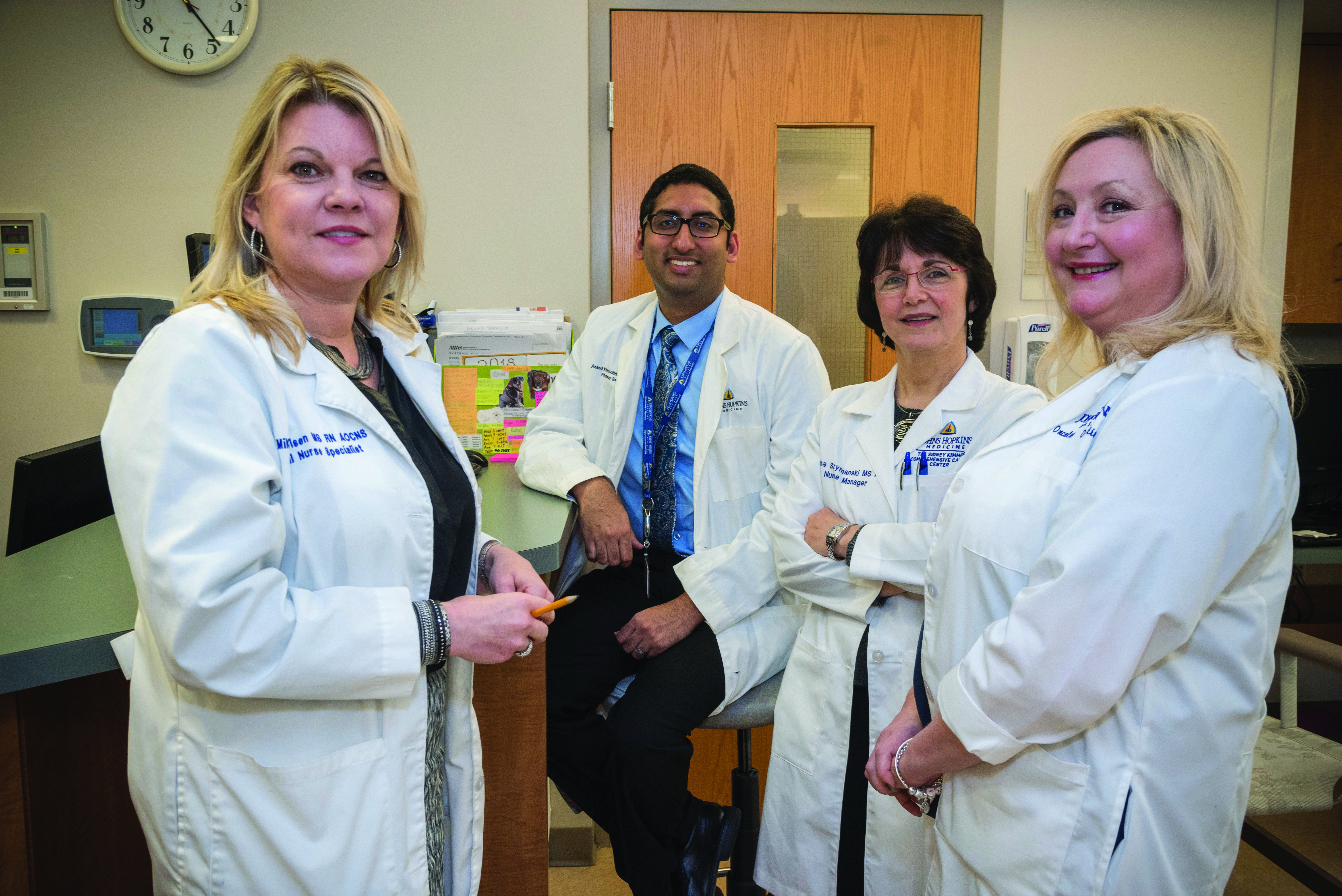- Interprofessional teams (https://voice.ons.org/topic/interprofessional-teams)
- Interprofessional issues (https://voice.ons.org/topic/interprofessional-issues)
- Clinical practice (https://voice.ons.org/topic/clinical-practice)
- Oncology nurse influence (https://voice.ons.org/topic/oncology-nurse-influence)
Interprofessional Collaborations Improve Cancer Care
“Two heads are better than one.” It might be one of the most commonly recited idioms in the English language, but that’s because it holds true time and time again.
When faced with a difficult problem, it’s human nature to seek different perspectives, to work together with others facing similar issues to accomplish a common goal. Compromise, collaboration, and communication are essential to successful teams—whether it’s your daughter’s basketball team, the U.S. government, or any group in between.
In oncology, teamwork is no different. Bringing together professionals from different disciplines can yield tremendous results for patients with cancer. By pulling in different perspectives from nurses, physicians, pharmacists, social workers, chaplains, and more, interprofessional teams can draw from the expertise of their members to provide the best possible care for patients. Creating a spirit of open collaboration and cross-departmental teams requires planning, hard work, and a willingness to share ideas. Oncology nurses around the country are forging new collaborations with their interprofessional colleagues to improve care for their patients.

The Need for Interprofessional Teamwork
The complexity of medical care—especially cancer care—requires coordination of different healthcare professionals across a spectrum of educational backgrounds and expertise. But in many institutions, cancer care is siloed and segregated among disciplines. Although interactions between departments and disciplines occur, the focus on sustained teamwork isn’t emphasized.
“If you don’t know what you’re missing, you don’t miss it,” ONS member Polly Mazanec, PhD, ACNP-BC, AOCN®, ACHPN, FPCN, of the Frances Payne Bolton School of Nursing at Case Western Reserve University in Cleveland, OH, says. “Different professions will tackle problems from different perspectives. So there’s no question that high-quality cancer care must be delivered through interprofessional teams. Nurses are obviously skilled at screening for distress, spiritual angst, physical symptoms, and so much more, but we need our colleagues to work with us to develop a patient-centered plan for our patients and their families.”

In a complex healthcare system, it can be daunting to identify an outlying problem and take steps to fix it, especially when it means coordinating across multiple disciplines. However, that’s exactly what happened at Johns Hopkins Hospital in Baltimore, MD, when a team of oncology nurses, pharmacists, and physicians recognized that patient satisfaction was dropping because of long wait times. ONS members Gina Szymanski, MSN, RN, Mikaela Olsen, MS, APRN-CNS, AOCNS®, and Mary Beth Collins, MSN, RN, assembled a team alongside their pharmacy colleagues to create real practice change. They collaborated with Anand Khandoobhai, PharmD, MS, acting division director for Weinberg Oncology Pharmacy.
“Our wait times were anywhere from 30 minutes to five hours,” Szymanski and her team notes. “We were providing chemotherapy to between 150 and 180 people per day at our infusion clinic. Leading into this problem, we had staffing issues, capacity issues, issues with unsigned orders or not having orders to the pharmacy until the day of treatment, and the pharmacy was having issues with capacity as well. It was a workflow challenge, and we weren’t able to be prepared to see our patients.”
Szymanski and her team recognized the systemic issues within their institution and sought change through by forming an interprofessional team focused on reducing wait times. They brought together nurses and pharmacists to actively plan and assess patients who were coming in for treatment and to determine whether their chemotherapy could be prepared in advance.
Crossing Disciplinary Lines
Szymanski and her team planned for nearly a year in what they called “warzone meetings” before they finalized a course of action and assembled their ambulatory clinical evaluation (ACE) team. The ACE team brought together nurses and pharmacists to collaborate and prepare for patients receiving chemotherapy in the days leading up to their treatment. But the process wasn’t easy.
“At the beginning, there wasn’t really a relationship between nursing in the infusion clinic and the pharmacy,” Szymanski notes, speaking on behalf of the team. “They were separate entities and didn’t get along that well. So, the first thing we did was invite our pharmacy colleagues into the clinic and said, ‘Okay. We’re all one team now. We’re going to make this work, and we’re going to figure out solutions.’”
Bridging the gap between disciplines requires open lines of communication and a willingness to see things from another’s point of view. Mazanec recognizes that it’s a learning experience for all involved and egos have to take a back seat to the importance of patient care.
“At the Cleveland VA hospital, we had assembled a large interprofessional cancer team of physicians, oncology fellows, advanced practice nurses, social workers, and even psychology doctoral students,” Mazanec recalls. “Every one of those healthcare providers brought something unique and different to the table. We saw that a big component for success was learning about the other team member’s roles and respecting and valuing those roles.”
Raising awareness of the intricacies of each profession is important to understanding how an interprofessional team can move forward to accomplish their goal. At Johns Hopkins, the ACE team was building trust between nurses and pharmacists. With that new level of trust came a deeper understanding of the problems each discipline faced when tackling longer wait times. It ultimately helped them join together to develop a solution that worked for everyone.
“We were concerned about the safety issues associated with preparing chemotherapy for patients ahead of time, not to mention the potential for increased waste if patients didn’t come in for treatment,” Szymanski and her colleagues remember. “Pharmacy did a waste analysis prior to the ACE team’s program to understand why drugs were getting wasted. Based on the results, nurses and pharmacists developed a screening tool that led to a phone assessment, which was a crucial part of the ACE team’s program.”

Success in Team-Based Cancer Care
Establishing the ACE team set the providers at Johns Hopkins on a path of developing new procedures to screen and assess patients prior to their chemotherapy administration. They also instituted new rules—backed by their administration and medical director—to ensure that orders and notes were submitted well in advance of treatment. The pharmacists researched drugs that were safe to be stored over a period of time and could be approved to work within the ACE team’s program. All of their hard work led to big change for their patients.
“Our wait times are currently down to 34 minutes for standard of care,” Szymanski says. “In the past, we had patients waiting up to five hours. Our goal is to have the drug ready at the appointment time. Patients show up, check in, and the drug is ready when they come back.”
Mazanec says that her experience has shown that interprofessional collaborations are addressing many issues that routinely distress patients. By tackling those problems in care, teams are closing gaps and improving the quality of life for their patients.
“When we have more than one person providing care, we’re going to see increased patient satisfaction, and we’re going to see a more holistic form of care,” Mazanec says. “You need to have more than one profession to address patient outcomes. Working together, you can improve patient knowledge with coaching, you can improve their distress with psychosocial support, and you can work with oncologists for medical management. There’s no doubt about it—it’s going to help patients to have more than one team member involved in their care.”
The Future of Interprofessional Collaborations
Mazanec notes that interprofessional collaborations can be a huge boon for survivors—both now and in the future. With an ever-growing population of people living after cancer, survivor needs are going to play a huge role in the future of all oncology professions. Interprofessional teams can help address that growing challenge.
“We—as oncology professionals—have been so focused on getting our patients to survivorship that we didn’t realize how much they were going to need in terms of care once we got them there,” Mazanec says. “They need comprehensive care in terms of physical, psychological, spiritual, and social well-being. Interprofessional teams will play a huge role in that work.”
The team at Johns Hopkins has come to recognize the ease at which it’s possible for them to extend their interprofessional relationships to issues beyond reducing patient wait times. Collaboration begets more collaboration.
“It really took a village to get our work done,” Syzmanski says on behalf of the team. “At this point, it’s a well-oiled machine. We have meetings to check in and to clear more drugs, but what has been most valuable, in terms of sustainability, is that if we encounter new problems, we have instant collaboration. It might seem silly to say, but we’re all married to each other now, and it’s like we have the ability to read each other’s minds. We problem solve faster than ever before.”
Ultimately, interprofessional collaboration is finding its way into institutions large and small. The ability to access multiple professional perspectives to problem solve institutional issues or medical complications can only lead to a higher level of care for patients. Through dedicated teams, nurses and their oncology colleagues are working together to make a difference in clinical practice.
